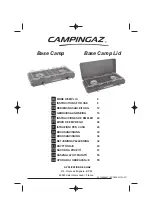
18
19
GENERAL HINTS AND TIPS
USING THE COOKER
Gas hotplates (Energy rating)
1
2
3
4
1
Medium heat burner (9.0 MJ/h)
Used for normal cooking and simmering with mid size
cookware items.
2
High heat burner (12.1 MJ/h)
Used for fast heating with large size cookware items.
3
Intense heat wok burner (14.2 MJ/h)
Used for very fast heating with woks and other large
size cook ware items.
4
Low heat burner (5.1 MJ/h)
Used for simmering and for use with small cookware
items.
NOTE: Energy ratings above are for natural gas (NG)
models.
To conserve gas, place the pan centrally over the burner
and adjust the flame so that it does not go past the
edge of the cookware.
NOTE: In the absence of electrical power, carry out the
ignition directly to the burner with a hand held ignition
source.
General hints
For best baking results preheat oven for 30 minutes.
The material and finish of baking trays and dishes used
will affect the way foods are baked, especially base
browning.
•
Enamelware, anodised aluminium, dark bakeware or
non-stick interiors and coloured exteriors will assist in
maintaining or reducing the baking time and increase
base browning.
•
Ovenproof glassware or ceramics are poor
conductors of heat. The shiny surface of aluminium
or polished steel utensils and trays also reflects the
heat rather then passing it through to the food being
baked.
•
Always place dishes in the centre of the shelf to
ensure even browning.
•
Stand casserole dishes on a baking tray to prevent
food from spilling onto the base of the oven.
•
Use ovenproof cookware, which will withstand
temperatures of 250°C.
•
Use shallow casserole dishes in preference to deeper
ones as this shortens cooking time in the oven.
WARNING
CAUTION
•
DO NOT place dishes, trays or baking pans directly
on the oven base as they become very hot and will
crack and craze the oven liner.
•
DO NOT use baking trays larger than 30 x 35cm
(12 x 14 inches) as they will restrict the circulation
of the heat and may affect cooking performance of
the oven.
Conventional Oven
•
The shelf position is critical. The temperature in
centre of the oven is the temperature shown on the
oven control knob. Single shelf baking gives optimal
cooking results.
•
DO NOT place baking trays, oven dishes or foil
directly on the base of oven, as trapped heat will
crack and craze the floor of the oven liner.
Fan Forced
•
Make sure shelves are evenly spaced.
•
When baking more than one dish in fan forced oven,
place dishes centrally on shelves rather than several
dishes on one shelf.
•
When the oven is full you may need to allow a slightly
longer baking time.
•
When using different size trays or cooking different
types of food, cooking times may vary for each dish.
WARNING
CAUTION
•
DO NOT place baking trays and oven dishes
directly against the grid covering the fan at the back
of the oven.
•
DO NOT place oven dishes directly on the oven base.
TIPS & INFORMATION
TIPS AND INFORMATION
Condensation and Steam
•
During cooking steam may be produced which can
be released when opening the oven door. This is
quite normal.
•
If there is any build-up of condensation on the oven
door it is recommended that it be carefully wiped
away either during or after cooking.
WARNING
WARNING
Always stand back from heated oven when opening oven
door to allow any build-up of steam or heat to release.
WARNING
WARNING
Door glass is a tough and durable material designed
to withstand heating and cooling without breaking.
However it must be remembered that it is glass and may
break, therefore must be treated with care.
If you have any questions about the glass in the oven
please contact the Service Centre on 13 13 49 (Australia)
or 0800 436 245 (New Zealand).
GENERAL HINTS AND TIPS
Summary of Contents for WFE512 Series
Page 20: ...38 39 NOTES NOTES NOTES NOTES ...







































